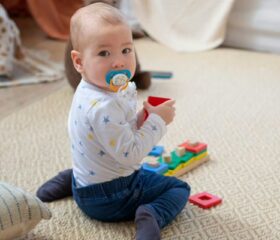When Do Babies Understand What “No” Means?
“No” is an important command for setting healthy boundaries for your baby. When will it stop being just another random sound and actually make sense to her?

To effectively use the word “no,” you need to make sure your child is old enough to grasp the concept and that you use it correctly.
Keep reading to find out when babies can understand “no,” how to teach them the word, and alternative methods to set boundaries.
When will your baby understand the word “no”?
According to the United Nations Children’s Fund (UNICEF), most babies start to understand the word “no” by nine months old. 1
Keep in mind that this is just an average. Don’t fret if your nine-month-old doesn’t quite grasp what “no” means yet. Your child will develop at her own pace and process the word when she’s ready.
That said, it’s a good idea to talk to your doctor if your child still doesn’t understand “no” by 15 months old. 2 Your doctor can assess if your child is developmentally behind and needs intervention—or if she just isn’t a big follower of commands.
How to teach your baby the word “no”
Unlike words like “ball” or “cup,” you can’t simply point to an object when teaching your child the concept of “no.” However, you can use non-verbal signals to help reinforce your message.
Follow these guidelines to teach the word effectively:
- Give accompanying cues: To help your baby associate the word “no” with disapproval, use a firm, slightly raised voice when you say it. You can also give her a frown and a head shake to convey your seriousness.
- Keep a straight face: It can be tough to resist a giggle when your baby does something objectively funny, such as flinging peas across the room. However, laughing can suggest you approve of the unwanted behavior and unintentionally reinforce it.
- Stay consistent: A key discipline tip is to remain consistent about which behaviors are unacceptable. When your response to “no” behaviors is reliable and predictable, your child quickly learns what to expect.
- Avoid overusing it: Parents sometimes don’t realize how often they say the word “no” to their children. The more your child hears “no,” the more the word loses its meaning. Be sure to save “no” for safety issues or behaviors that truly require an immediate stop. 3
Always be explicit and clarify what the “no” is for. For instance, if your baby is hitting, after saying “no hitting,” tell her what she should be doing instead. You can say “gentle” calmly while guiding her hand to touch softly. Remember to praise good behavior to encourage it further.
No matter how frustrated you get, never yell or hit your child. Doing so doesn’t work and teaches your child aggressive behaviors. 4 If you feel overwhelmed, make sure your child is in a safe space, then step aside for a moment to calm yourself down.
Other effective ways to set boundaries
Again, many parents tend to overuse the word “no,” which is understandable (children can be a handful). Nonetheless, it’s important not to diminish the word’s impact in situations when it’s truly warranted.
Rather than defaulting to “no” for every issue, try setting boundaries and guiding your little one with these more nuanced approaches.
Acknowledge and redirect
Start by acknowledging your child’s curiosity and validating her feelings, then gently redirect her to a more acceptable behavior. 3
For example, if your baby is playing and creating a mess with applesauce, you can:
- Say to her, “I see you really want to eat that applesauce with your hands. It looks fun!”
- Gently lift her hands from the mess, give her a spoon, and tell her, “Let me show you how we use the spoon to keep things less messy.”
Create physical distance
Another effective way to avoid saying “no” is to physically distance your baby from the unwanted activity. For instance, if your baby is pulling your hair, gently put her down to create space. If she’s bothering a pet, move her to another area.
Eventually, even without the word “no,” your baby will connect the unwanted action with the separation.
Anticipate and prevent undesirable behaviors
The best-case scenario is that you don’t have to correct your baby’s behavior. As mentioned, babies aren’t intentionally trying to cause trouble; they’re just curious about their surroundings and act on impulse.
You can reduce the need to say “no” or correct your baby’s behavior by:
- Childproofing your home: Childproof every corner of your house, making it a safe space for your child to play and explore without constant intervention.
- Providing alternative distractions: If your little one is reaching for something off-limits, offer her a toy and put away the dangerous item when she’s not looking.
Babies are often more likely to act out when they’re tired and frustrated. Try to anticipate those situations to get ahead of potential issues. For example, if you know your baby tends to pull your hair when she’s tired, put your hair in a ponytail when you notice she’s getting fussy.
How and when to approach disciplining your baby
The idea of “disciplining” a baby can seem harsh. However, it isn’t about punishing your child, just communicating when a behavior is unsafe or unwelcome.
With that in mind, it’s never too early to start guiding your child. Setting age-appropriate boundaries lays the groundwork for making good choices as your little one grows.
Note that the key is “age-appropriate.” It’s important to keep your expectations in check. For instance, it’s normal for your baby to keep throwing food on the floor, even after you tell her not to. Believe it or not, your baby isn’t trying to be naughty, just exploring cause and effect and developing her fine motor skills.
Be patient as you teach her right from wrong. In time, your message will get through to her, and she’ll learn the right behaviours.
Final thoughts
It’s easy to find yourself constantly saying “no” to your baby, especially if, like many very young children, she seems to always be pushing boundaries.
The next time you catch yourself about to pull the “no” card, take a second to consider if there’s a better way to resolve the issue.
Use “no” purposefully, and be patient if she doesn’t listen right away. Soon enough, your baby will know what it means and even pick up the word herself once she starts talking (that may become a whole other issue, but it’s a good problem to have).
Article Sources
- UNICEF. "Your baby's developmental milestones at 9 months" Retrieved November 11, 2025.
- Healthline. "Language Milestones: 1 to 2 Years" Retrieved November 11, 2025.
- American Academy of Pediatrics. "Milestone Moments Checklist" Retrieved November 11, 2025.
- University of Rochester Medical Center. "Disciplining Your Child at Any Age" Retrieved November 11, 2025.







